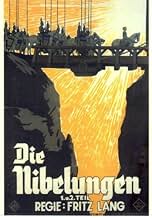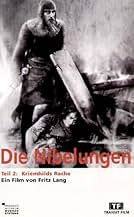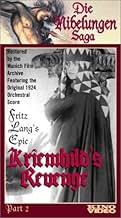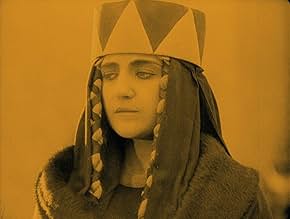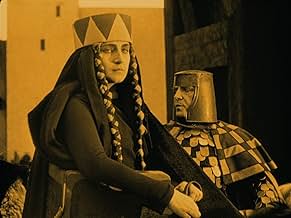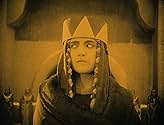Los nibelungos - 2ª parte: La venganza de Krimilda
Título original: Die Nibelungen: Kriemhilds Rache
PUNTUACIÓN EN IMDb
7,9/10
5,3 mil
TU PUNTUACIÓN
Añade un argumento en tu idiomaPrincess Kriemhild vows to avenge her husband's murder but must overcome her brothers who swore allegiance to Hagen. She marries Etzel, King of the Huns, and persuades his army to attack Hag... Leer todoPrincess Kriemhild vows to avenge her husband's murder but must overcome her brothers who swore allegiance to Hagen. She marries Etzel, King of the Huns, and persuades his army to attack Hagen, but she loses more than she bargained for.Princess Kriemhild vows to avenge her husband's murder but must overcome her brothers who swore allegiance to Hagen. She marries Etzel, King of the Huns, and persuades his army to attack Hagen, but she loses more than she bargained for.
- Premios
- 1 nominación en total
Yuri Yurovsky
- The Priest
- (as Georg Jurowski)
Reseñas destacadas
"Die Nibelungen: Kriemhild's Revenge" is part of the two-part, five hour long saga from Fritz Lang. The first part, "Die Nibelungen: Siegfried" follows the Germanic hero from various heroic deeds (such as slaying a dragon) to his eventual murder.
When part two begins, his widow, Kriemhild is naturally furious. After all, her husband was murdered and no one has been punished. To make it worse, her family has sworn allegiance to the murderer! The movie consists of her machinations to bring the killer to justice, though through this there are wars, lots of death and an ending where practically everyone expires!
What I didn't love were the English captions added to the film. They were is a VERY stylized Germanic font...and were VERY difficult to read. I also was not fond of an overuse of staring and folks standing at attention instead of ACTING (a problem also in Sergei Eisenstein's "Ivan the Terrible" saga). It also should be noted that in this English version, King Etzel is translated as King Attila (as in, Attila the Hun).
What were exceptional were the costumes, the sets (some of which were pretty simple but others really were amazing) and the wonderful print (it was pristine) I found of it on YouTube.
When part two begins, his widow, Kriemhild is naturally furious. After all, her husband was murdered and no one has been punished. To make it worse, her family has sworn allegiance to the murderer! The movie consists of her machinations to bring the killer to justice, though through this there are wars, lots of death and an ending where practically everyone expires!
What I didn't love were the English captions added to the film. They were is a VERY stylized Germanic font...and were VERY difficult to read. I also was not fond of an overuse of staring and folks standing at attention instead of ACTING (a problem also in Sergei Eisenstein's "Ivan the Terrible" saga). It also should be noted that in this English version, King Etzel is translated as King Attila (as in, Attila the Hun).
What were exceptional were the costumes, the sets (some of which were pretty simple but others really were amazing) and the wonderful print (it was pristine) I found of it on YouTube.
Like the first movie, The Nibelungs: Siegfried, the second part named Kriemhild's Revenge is a fantastic and epic piece with fantastic settings, imagination and acting. I really like from time to time to drown myself in those old movies, that are most imaginative and an art form and nothing less, and in comparison, most of today's movies are exposed for what they are, products of a soulless and unimaginative mass industry that does not attract genius and talent but mediocrity.
This second half of Fritz Lang's epic filming of the Nibelungen Saga has many of the same strengths as the first, with memorable characters and interesting, atmospheric settings. This part of the story continues with many of the same characters, but the story itself is of a much different nature. There is less complexity but more action, with the entire focus being on Kriemhild and her inflexible desire for revenge. This part of the story does not have such interesting relationships amongst the characters as did the first part, but instead provides first and foremost an unforgettable portrait of the obsessed Kriemhild.
She, Gunther, and Hagen are now thoroughly defined characters who have chosen where they stand, and so there is not the kind of dramatic uncertainty and tension that the first part held. Instead, there is a more straightforward battle of wills, but with an added wild card in the person of Attila, portrayed memorably and with great energy by Rudolf Klein-Rogge. Attila and the Huns are depicted in a way that most likely has little basis in history, but it is certainly interesting to see the bizarre fashion in which the Huns and their world are portrayed. As events unfold, the developments are not always fully plausible, but the stakes and the pressure on each side steadily rise, building to an intense climax.
What you remember most after the film is over is the remorseless, implacable Kriemhild. With her costume obscuring almost everything else, Margarete Schön portrays the depth of Kriemhild's emotions and determination using only her face and, especially, her eyes. It is about as memorable a portrait as you will find in cinema of the madness and destructive fury of revenge. While "Kriemhild's Revenge", as a whole, does not have the thematic depth of "Siegfried", it succeeds in establishing this central image in a manner not easily forgotten.
She, Gunther, and Hagen are now thoroughly defined characters who have chosen where they stand, and so there is not the kind of dramatic uncertainty and tension that the first part held. Instead, there is a more straightforward battle of wills, but with an added wild card in the person of Attila, portrayed memorably and with great energy by Rudolf Klein-Rogge. Attila and the Huns are depicted in a way that most likely has little basis in history, but it is certainly interesting to see the bizarre fashion in which the Huns and their world are portrayed. As events unfold, the developments are not always fully plausible, but the stakes and the pressure on each side steadily rise, building to an intense climax.
What you remember most after the film is over is the remorseless, implacable Kriemhild. With her costume obscuring almost everything else, Margarete Schön portrays the depth of Kriemhild's emotions and determination using only her face and, especially, her eyes. It is about as memorable a portrait as you will find in cinema of the madness and destructive fury of revenge. While "Kriemhild's Revenge", as a whole, does not have the thematic depth of "Siegfried", it succeeds in establishing this central image in a manner not easily forgotten.
Impressive sets, costumes, and action highlight this 2 hour conclusion. The surprisingly good restoration was available for both parts on Netflix.
In some ways I suspect intentional and not, the movie subtext lays out the cultural flaws of the German/Austrian people following World War 1. The Burgundian oath upheld despite treachery and infanticide to the point of self destruction. An overwhelming need for revenge with no compromise or limit to the cost of obtaining it.
I imagine Fritz Lang and his co-writer wife sought to emphasize these faults following the war, which leads to the mutual destruction of the entire lot of Burgundy characters. Curiously the result ennobles both sides.
The non Germanic characters are grubby, disfigured, inferior animals. Only the extremes of pride, honor and infighting seem to hold the Germanic kingdom back. Within this subtext, one might see omens for the world that would be realized less than 15 years later.
The resulting film shares the same fault of its characters. Excessive pride, honor and nationalism despite the destruction and failure it had wrought. It is a vast epic and well made. But more importantly, a view of the cultural undercurrents that undermined the treaties from the war to end all wars.
In some ways I suspect intentional and not, the movie subtext lays out the cultural flaws of the German/Austrian people following World War 1. The Burgundian oath upheld despite treachery and infanticide to the point of self destruction. An overwhelming need for revenge with no compromise or limit to the cost of obtaining it.
I imagine Fritz Lang and his co-writer wife sought to emphasize these faults following the war, which leads to the mutual destruction of the entire lot of Burgundy characters. Curiously the result ennobles both sides.
The non Germanic characters are grubby, disfigured, inferior animals. Only the extremes of pride, honor and infighting seem to hold the Germanic kingdom back. Within this subtext, one might see omens for the world that would be realized less than 15 years later.
The resulting film shares the same fault of its characters. Excessive pride, honor and nationalism despite the destruction and failure it had wrought. It is a vast epic and well made. But more importantly, a view of the cultural undercurrents that undermined the treaties from the war to end all wars.
I saw this film last night at a special movie theater showing in Nürnberg, and it was superb. I do have to admit that the original music composition of the cello player and percussion/xylophone player influenced the mood of the film, but the film itself also had force in its portrayal of the tragic Nibelungen saga.
If you are interested in silent films or in the Nibelungenlied, I highly recommend this film. The costumes were fantastic and creative, the sets were opulent and exotic, and the acting was dramatic and breathtaking (as is typical of silent film "tragedies") Unfortunately, I have not seen the first part of this film duo that concerns Siegfried. The story of this second film begins after Siegfried's death, when Kremhild (Gudrun in the Norse versions of the story) begins to plan her revenge against her brothers.
Also, I watched this film in German; I am a native English speaker and have a basic German knowledge. It was difficult to read the ?subtitles (what do you call that in silent films?) at first because of the old style German script, so I advise that if you watch it in German that you make sure you can differentiate your "k's", "f's", and "s's" in the old script. :)
If you are interested in silent films or in the Nibelungenlied, I highly recommend this film. The costumes were fantastic and creative, the sets were opulent and exotic, and the acting was dramatic and breathtaking (as is typical of silent film "tragedies") Unfortunately, I have not seen the first part of this film duo that concerns Siegfried. The story of this second film begins after Siegfried's death, when Kremhild (Gudrun in the Norse versions of the story) begins to plan her revenge against her brothers.
Also, I watched this film in German; I am a native English speaker and have a basic German knowledge. It was difficult to read the ?subtitles (what do you call that in silent films?) at first because of the old style German script, so I advise that if you watch it in German that you make sure you can differentiate your "k's", "f's", and "s's" in the old script. :)
¿Sabías que...?
- CuriosidadesAttila's castle was built life-size. The fire was started by Fritz Lang himself by shooting an arrow, tipped with burning magnesium, onto the roof.
- PifiasAt 19:38, as you see the treasure in the water, you can see a hand in the reflection to the left of the sword. Presumably it was filmed in a fish tank.
- Versiones alternativasA 2012 restoration project completed by the Friedrich-Wilhelm-Murnau-Stiftung has been released by Kino Lorber on both DVD and Blu-ray formats. Both "Die Nibelungen: Siegfried" (1924) and "Die Nibelungen: Kriemhild's Revenge" (1925) are included. The film's running times differ from other versions at 149 minutes and 131 minutes, respectively. This can be attributed to the fact that the restoration utilized some footage from different takes of scenes and slight adjustments were made to the 'frames-per-second' rate perhaps to present a more realistic flow of the action.
- ConexionesEdited into Fritz Lang - El círculo del destino (2004)
Selecciones populares
Inicia sesión para calificar y añadir a tu lista para recibir recomendaciones personalizadas
- How long is Die Nibelungen: Kriemhild's Revenge?Con tecnología de Alexa
Detalles
- Fecha de lanzamiento
- País de origen
- Idioma
- Títulos en diferentes países
- Die Nibelungen: Kriemhild's Revenge
- Localizaciones del rodaje
- Empresas productoras
- Ver más compañías en los créditos en IMDbPro
- Duración2 horas 9 minutos
- Mezcla de sonido
- Relación de aspecto
- 1.33 : 1
Contribuir a esta página
Sugerir un cambio o añadir el contenido que falta

Principal laguna de datos
By what name was Los nibelungos - 2ª parte: La venganza de Krimilda (1924) officially released in India in English?
Responde

